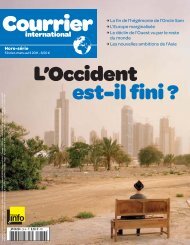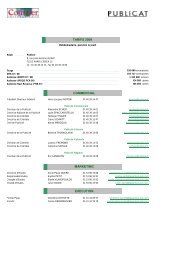2 ОРГАНИЗАЦИЯ И МЕТОДИКА РАБОТ - Courrier international
2 ОРГАНИЗАЦИЯ И МЕТОДИКА РАБОТ - Courrier international
2 ОРГАНИЗАЦИЯ И МЕТОДИКА РАБОТ - Courrier international
Create successful ePaper yourself
Turn your PDF publications into a flip-book with our unique Google optimized e-Paper software.
unidentified substances occurs with high efficiency. This method provides a degree of<br />
transformation of organic pollutants into nontoxic components of at least 99,9%.<br />
Along with the advantage of the method is necessary to note its shortcomings. These are, first<br />
and foremost, you must include the following aspects.<br />
First, the unit cost method SCWO is much higher than almost all existing methods of elimination<br />
of industrial hazardous wastes.<br />
Second, it is required to develop the preliminary preparation procedure of waste to be eliminated,<br />
including deactivation of toxic substances. The need to prepare water solutions of pollutants to<br />
be eliminated may lead to economic unprofitability of the method.<br />
Third, the restriction can be traced to the possibility of highly toxic substances elimination using<br />
SCWO due to their preliminary neutralization. Thus, in the case of detoxication of compounds<br />
with reagent method, a multicomponent system will be created containing an organic component<br />
of exhaust gases (mainly - acid gases). It will require the development of a preliminary stage of<br />
clean up sufficiently large in size and power consumption for further implementation of<br />
SCWO. This situation applies fully to the preparation using the methods of physical effects: UV,<br />
IR - radiation, thermal effects, etc.<br />
Fourth, the unresolved problem is the deposition of solid products resulting from water oxidation<br />
and the consequent blockage of communications and stop of the process.<br />
The method of electrohydraulic [61] shock is based on the effect of short-pulse high-voltage<br />
electrohydraulic discharge on the organic components in a liquid medium. EHS combines<br />
simultaneous effect on the substance of strong mechanical compression of powerful ultrasound,<br />
hard X-ray, ultraviolet and infrared radiation. The electromagnetic fields formed during the<br />
discharge also have a strong impact both on the discharge itself, and on the ionic processes<br />
occurring in surrounding fluid. Under their influence different physical and chemical changes<br />
and chemical reactions occur in the processed materials<br />
.<br />
The effectiveness of this method is confirmed by the results of studies by Russian scientists<br />
[62.63], which established the possibility of coversion of wastewater containing benzene, phenol,<br />
saturated hydrocarbons into environmentally safe compounds - elementary carbon carbon (soot),<br />
carbon monoxide (IV), water. In addition, high efficiency was proven of disinfection of<br />
wastewater from E. coli, spores of anthrax vaccine and antrakoida.<br />
Analyzing the above method, it should be noted that significant negative aspects exist in terms of<br />
its applicability to the problem of the elimination of POPs: high cost of installation and power<br />
consumption, the need for preliminary preparation of water solutions (suspensions) of drugs, etc.<br />
On the basis of existing technical, environmental and economic requirements for POPs<br />
Elimination Technologies, all possible processes of PCB and spent oil elimination of PCB have<br />
been preliminarily assessed.<br />
The assessment shows that the most appropriate technologies for elimination of PCB is thermal<br />
method based on the technology of high-temperature oxidation.<br />
Thermal method of treatment is the most popular in the world practice of disposal of carbonic<br />
industrial and domestic waste. In addition, this method is cost effective and acceptable in terms<br />
of sanitary-hygienic rules, i.e. the final content of hazardous impurities after thermal<br />
decontamination does not exceed their maximum permissible concentrations.<br />
FINAL REPORT for Contract No. CS-NPA-Arctic-13/2009 of December 01, 2009 within the framework of pilot project Development<br />
of Technology of clean up of the area of Decommissioned Sites of The Russian Federation Ministry of Defense in the Arctic by the<br />
Example of Alexanra Island of Franz Josef Land Archipelago from Hazardous Waste<br />
149








